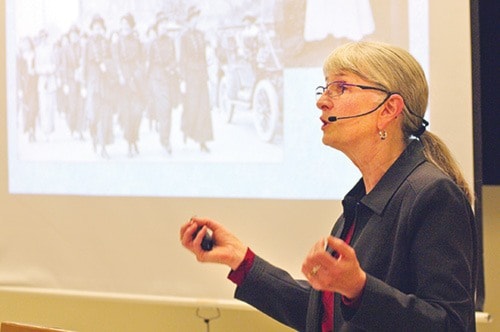“Like anyone else, and like the men, they wanted to serve. And being nurses so close the the battlefield was the only way they could do their bit.”
Victoria historian Yvonne Van Ruskenveld explained the motivation of young women in 1914 in joining the war effort as Britain called upon nurses to serve near the front during the First World War.
Van Ruskenveld, a member of the Old Cemeteries Society in Victoria, recently gave a presentation on the city’s battlefield nurses during the Great War to members of the Saanich Peninsula branch of the Canadian Federation of University Women (CFUW). Each October, she holds a women’s history tour in the Ross Bay Cemetery and a few years ago came across the names of two Canadian Nursing Sisters. The Nursing Sisters as an organization, first appeared in 1885, according to Veterans Affairs Canada, caring for soldiers sent to quell the North-West Rebellion. From that time, the Nursing Sisters joined every Canadian military force up to the Korean War. These days, nurses in the Canadian Forces no longer go by the term. They were known as the Nursing Sisters due in part to the religious background of wartime nursing, and the style of headgear they wore that resembled the habit of nuns.
During the First World War, Van Ruskenveld said there were more than 3,000 Nursing Sisters — the only women to be official members of the armed forces of Canada at that time.
One of those nurses from Victoria, Meta Hodge, won the Military Medal and is buried at Ross Bay. Van Ruskenveld became interested in those women, including Ethel Morrison, and the Nursing Sisters organization and sought to learn more.
At the time, when Britain called its men to war in Europe, the military saw a need for nurses and organized a series of general hospitals in Canada to help recruit women. Victoria’s General Hospital No. 5 was one of those, said Van Ruskenveld. From there, women would sign up for service the same way men would for soldiering.
“Many of those nurses learned to march out at Macaulay Point,” she added.
The first group of 100 nurses from B.C. and across the country were sent in 1914 to Valcartier, Quebec — the staging point for all military personnel heading to England out of Canada. There, they were given military training in drill and other duties such as hygiene and what kinds of wounds they could expect to see on the battlefront. A Nursing Sister, said Van Ruskenveld, had to be educated as a nurse, from the middle class, young (at least 21 years old) and single. At the beginning of the war, there were only 57 nurses in reserve. When they went overseas, said Van Ruskenveld, they were commissioned as lieutenants — both for respect reasons and to ensure the male orderlies would follow their commands.
Of the more than 3,000 Nursing Sisters to serve from Canada, just over 1,800 would be sent overseas. Most were assigned to medical facilities near Europe’s Western Front, while others would serve in Greece. Van Ruskenveld said in some cases the nurses were as close as three miles from the trench lines. They were tasked with preparing dressings and beds, did most of the dressing changes on wounded soldiers, fed and cleaned their patients and assisted in surgery. Van Ruskenveld said the Canadian medical corps was the first to use nurses as anaesthetists.
“When there was a battle coming up, they’d clear the hospitals,” Van Ruskenveld said. “They’d see things that they’d never been exposed to back home.”
They were exposed to harsh conditions, saw and treated terrible injuries and even came under fire. A German U-Boat attack in June of 1918 caused the sinking of the Canadian hospital ship Llandovery Castle that saw the death of 234 people, including all 14 Nursing Sisters on board. A bombing by enemy aircraft that same month in France killed three Nursing Sisters. Most nurses who died during the war, said Van Ruskenveld, did so due to disease.
When the surviving nurses returned home, many continued their work and began the transition to civilian life. Their lives are now a part of history, something that Van Ruskenveld hopes to share with other people and let them know what these women did in a time when the role of women in Canadian society was not as encompassing as it is today.
“I want people to know how brave these women were and how much they accomplished and how respected they were.”
In Ottawa at the Parliament Buildings, there is a memorial to the Nursing Sisters and the image of a nurse can be found on the veterans memorial statue nearby.
Van Ruskenveld said the work they did earned the respect of the people with whom they served.
— with files from Veterans Affairs Canada and the Canadian War Museum
